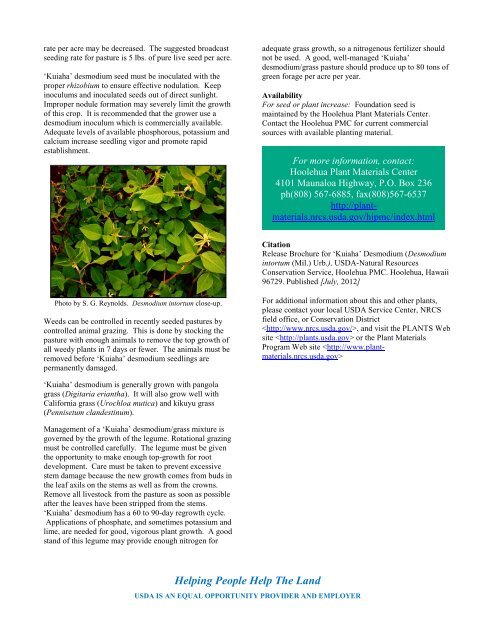Desmodium intortum - Plant Materials Program
Desmodium intortum - Plant Materials Program
Desmodium intortum - Plant Materials Program
You also want an ePaper? Increase the reach of your titles
YUMPU automatically turns print PDFs into web optimized ePapers that Google loves.
ate per acre may be decreased. The suggested broadcast<br />
seeding rate for pasture is 5 lbs. of pure live seed per acre.<br />
‘Kuiaha’ desmodium seed must be inoculated with the<br />
proper rhizobium to ensure effective nodulation. Keep<br />
inoculums and inoculated seeds out of direct sunlight.<br />
Improper nodule formation may severely limit the growth<br />
of this crop. It is recommended that the grower use a<br />
desmodium inoculum which is commercially available.<br />
Adequate levels of available phosphorous, potassium and<br />
calcium increase seedling vigor and promote rapid<br />
establishment.<br />
adequate grass growth, so a nitrogenous fertilizer should<br />
not be used. A good, well-managed ‘Kuiaha’<br />
desmodium/grass pasture should produce up to 80 tons of<br />
green forage per acre per year.<br />
Availability<br />
For seed or plant increase: Foundation seed is<br />
maintained by the Hoolehua <strong>Plant</strong> <strong>Materials</strong> Center.<br />
Contact the Hoolehua PMC for current commercial<br />
sources with available planting material.<br />
For more information, contact:<br />
Hoolehua <strong>Plant</strong> <strong>Materials</strong> Center<br />
4101 Maunaloa Highway, P.O. Box 236<br />
ph(808) 567-6885, fax(808)567-6537<br />
http://plantmaterials.nrcs.usda.gov/hipmc/index.html<br />
Citation<br />
Release Brochure for ‘Kuiaha’ <strong>Desmodium</strong> (<strong>Desmodium</strong><br />
<strong>intortum</strong> (Mil.) Urb.). USDA-Natural Resources<br />
Conservation Service, Hoolehua PMC. Hoolehua, Hawaii<br />
96729. Published [July, 2012]<br />
Photo by S. G. Reynolds. <strong>Desmodium</strong> <strong>intortum</strong> close-up.<br />
Weeds can be controlled in recently seeded pastures by<br />
controlled animal grazing. This is done by stocking the<br />
pasture with enough animals to remove the top growth of<br />
all weedy plants in 7 days or fewer. The animals must be<br />
removed before ‘Kuiaha’ desmodium seedlings are<br />
permanently damaged.<br />
For additional information about this and other plants,<br />
please contact your local USDA Service Center, NRCS<br />
field office, or Conservation District<br />
, and visit the PLANTS Web<br />
site or the <strong>Plant</strong> <strong>Materials</strong><br />
<strong>Program</strong> Web site <br />
‘Kuiaha’ desmodium is generally grown with pangola<br />
grass (Digitaria eriantha). It will also grow well with<br />
California grass (Urochloa mutica) and kikuyu grass<br />
(Pennisetum clandestinum).<br />
Management of a ‘Kuiaha’ desmodium/grass mixture is<br />
governed by the growth of the legume. Rotational grazing<br />
must be controlled carefully. The legume must be given<br />
the opportunity to make enough top-growth for root<br />
development. Care must be taken to prevent excessive<br />
stem damage because the new growth comes from buds in<br />
the leaf axils on the stems as well as from the crowns.<br />
Remove all livestock from the pasture as soon as possible<br />
after the leaves have been stripped from the stems.<br />
‘Kuiaha’ desmodium has a 60 to 90-day regrowth cycle.<br />
Applications of phosphate, and sometimes potassium and<br />
lime, are needed for good, vigorous plant growth. A good<br />
stand of this legume may provide enough nitrogen for<br />
Helping People Help The Land<br />
USDA IS AN EQUAL OPPORTUNITY PROVIDER AND EMPLOYER
















